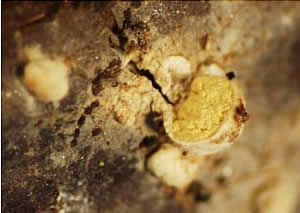Undescribed genus of Trichocomaceae

General status: Possibly endemic. This fungus belongs to a group rarely collected for the Southern Hemisphere. Its unusual combination of cleistothecial and ascospore features suggests no close relationship with known Trichocomaceae. It is known only from the shells of dead Paraphanta snails.
Population:?? Known from only 2collections, although these arefromwidely spaced localities (Waipoua and Karamea).
Decline: Total population unknown. Assuming this fungus is restricted to the shells of Paraphanta, any threat to the snail population will also present a threat to the fungus population.
Distribution: Northland and north-west Nelson.
Biology: The biology of this fungus isnot understood, but as both known collections were on shells of dead Paraphanta, the only evidence we have is that it may be restricted to this substrate. If this is the case, any threat to the snail population will present a threat to the fungus population. At present, with increased predation and disturbance resulting in larger numbers of dead Paraphanta shells on the forest floor, this fungus may temporarily be more common than usual.
